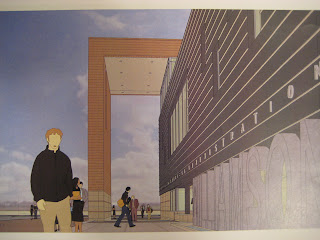
The photo above shows the entrance on the side of the building closer to campus, specifically the entrance closer to Hazel Street extension.
Now below is the site plan of the ground floor:

There are two auditoriums (in orange) on the ground floor, one at each end.
A central atrium splits into two hallways depositing to Wood Street on the side closer to the central business district. One exits to the pedestrian staircase along Phelps Street, the other runs inside parallel to Hazel Street.
The photo below is looking from beyond Wood Street, towards the central part of campus. This is the part of the building along the ridge as the elevation changes, that one that people will see when looking from down below near Cedars' parking lot.

Looking from a similar, but not identical perspective, were we see all the southernish facing windows from the atrium.
The third and top floor in this view shows the conference center.
The views from inside the conference center will have stunning angles of the skyscrapers downtown.

The next view shows the strong design element framing the space from the Hazel Street side.

Below is a cantilevered section, with the name "williamson" in galvanized steel supporting the load.

And below, from inside the atrium - with entrance to the trading floor.
Notice the walkways and stairways that face the atrium, leading to a kinetic feel of the building as people walk through it (and even to the bathrooms).

And here's a handsome fellow with a soulpatch, checking out the letters. This view is looing up towards the central campus.

When finished in summer of 2010, the LEED-gold certified building will double the size of the current building - and be a signature piece highlighting the successful cooperation between the city and the university.




1 comment:
It looks like a great building, and you mention on how it is great cooperation between the city and the university. But I suspect there still wasnt fair treatment to the private land and business owners in that area who has been pressured to sell their property to the university at less than replacement value. I still think it is ironic that a school that is suppose to teach the hallmarks of free markets was built on land that was purchased without such consideration of our fundamental right to own property.
Post a Comment